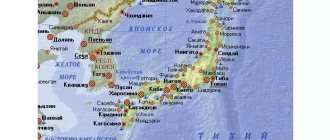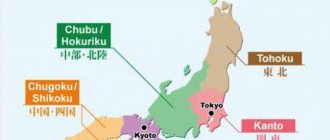On March 11, 2011, the largest earthquake in the history of the country, the Great East Japan Earthquake, and the resulting tsunami occurred off the coast of Japan. As a result, almost 20 thousand people died or went missing, about a million houses were destroyed, about half a million people were forced to evacuate.
But for many, the main event of those days was the accident at the Fukushima Daiichi nuclear power plant, the largest accident at a nuclear power plant since the Chernobyl disaster. The tsunami cut off power to the station, caused overheating of the reactors and subsequent explosions of three power units during March 12-15. As a nuclear physicist, I watched the events of those days, worrying about the people in Japan and my industry colleagues at the station. Much has already been written about the causes of the accident and the events of those days. But in my article I want to talk not about this, but about the consequences of the accident - for people, the environment and the global nuclear industry, and about what has been done over these 10 years.
Release, pollution of territory and ocean
The main releases of radioactive substances occurred in the first two weeks of the accident. They began a day after the tsunami and the blackout of the nuclear power plant, and were associated with successive explosions at units No. 1 (March 12), No. 3 (14th) and No. 4 (15th). Moreover, until March 15, the release went towards the sea. Water used to cool the reactors was also drained there. Therefore, up to 80% of emissions from the Fukushima nuclear power plant ended up in the ocean rather than on land.
Unlike Chernobyl, 3 reactors were destroyed at Fukushima, not just one. However, their cores did not explode, so the emissions contained practically no transuranium elements and fuel particles, but contained mainly volatile components and noble gases. The main ones from a health hazard point of view are iodine (mainly I-131) and cesium (mainly Cs-137). The first has a half-life of only 8 days and is dangerous in the early stages of an accident. The second has a half-life of 30 years and detects long-term pollution. The total release of I-131 (up to 200 PBq) and Cs-137 (up to 16 PBq) amounted to about 10-15% of Chernobyl emissions.
The main contamination of the territory is a trace of fallout to the northwest of the nuclear power plant at a distance of about 40 km. At the same time, the area of territory with contamination of more than 185 kBq/m2 (or 5 Ci/km2) in 2011 amounted to about 1,700 km2 - 6% of the area of pollution of the same level after Chernobyl). Of these, 75% are forests, about 20% are farmlands and 5% are settlements. By 2014, the area of such pollution had decreased to 600 km2.
The density of radiocesium fallout (134th and 137th is approximately half).
Emissions of Cs-137 into the ocean through the atmosphere are estimated at 5-8 PBq. (IAEA Report, page 38), and another 1 to 6 PBq of Cs-137 entered the ocean through direct discharges from the plant during the accident.
But here it is important to remember that there was cesium in the ocean before Fukushima. This is an artificial radionuclide, but “thanks to” atmospheric testing of nuclear weapons (I wrote about this in part in a previous article about nuclear disarmament), more than about 300 PBq of it have already accumulated in the world’s oceans. Specifically, in the northern part of the Pacific Ocean - about 70 PB, i.e. at least 5 times more than what Fukushima added.
Modeling the spread of Cs-137 from nuclear power plants in the ocean. You can see how quickly the ocean dilutes it.
The diagram above shows that the discharged Cs-137 quickly diluted to concentrations of 1 Bq/m3 and below. The pre-accident level of Cs-137 in seawater was about 3 Bq/m3. For comparison, the standard for drinking water according to the requirements of the World Health Organization is 3000 times higher - up to 10,000 Bq/m3 (10 Bq/l). So, traces of Fukushima cesium, of course, can be detected off the coast of the United States with good equipment, but it does not pose a danger to human health.
However, cesium can accumulate in fish. Therefore, at first, fishing in the area of the nuclear power plant was generally prohibited, and then all products were subjected to careful control. Although the tsunami already caused damage to fishermen, destroying 10% of all fishing vessels in Japan. However, levels of cesium in fish samples have declined over the years. If after the accident up to 57% of the samples taken showed an excess of the Japanese standards of 100 Bq Cs-137 per kilogram of fresh weight of fish, then since April 2015 no such excesses have been found (see the article and the picture from it below), and in most samples the cesium content was below 5 Bq/kg. At the same time, WHO recommendations for the content of cesium in food, even for children, are up to 1000 Bq/kg. Therefore, restrictions on fishing in the prefecture were eventually completely lifted.
Results of monitoring the content of Cs-137 in fish from Fukushima Prefecture by year. ND - detection limit, equal to 5 Bq/kg
But all these figures, as usual, are not very important to the general public, since there are still concerns about all products from Fukushima Prefecture both within Japan and abroad. Up to 10% of Japanese still prefer not to buy products from Fukushima Prefecture. And in 6 countries the import of products from Japan is still prohibited, and in another 9 they are being checked. Although 39 countries have lifted previously imposed restrictions. The seafood catch in the prefecture has so far recovered to only 12% of its pre-accident level.
Impact of a major earthquake
All nuclear power plants in Japan were built taking into account the inevitability of strong tremors. Calculations were made even for such a large earthquake, which happened on March 11, 2011 in the Pacific Ocean. It was on this day that the interaction of the Okhotsk continental plate, as well as the Pacific oceanic plate trying to submerge under it, took place. This caused the largest earthquake in the country. But it was not only vibrations of the surface and the bowels of the earth that had such tragic consequences. Just 30 minutes after the first shock, a tsunami hit the island of Honshu. In different parts of the territory its height had significant differences. However, it reached its maximum off the coast of the northeastern Iwate Prefecture. Here, a wave reached the city of Miyako, the height of which reached 38-40 m. But in the territory where the large city of Sendai is located, the water element moved inland to a distance of 10 km, flooding the airport.
It was the tsunami that became the main cause of the huge number of casualties, as well as serious destruction. The ocean wave washed away towns and cities, destroyed communications and houses, overturned trains, planes and cars.
Victims and victims
In the first days after the accident, residents within a 20 km radius around the nuclear power plant were evacuated, and then additionally residents of contaminated areas outside this area were evacuated. All of them are located inside Fukushima Prefecture. In total, 164 thousand people were evacuated from the prefecture with a population of 1.8 million people for all reasons, due to the tsunami, earthquake and nuclear power plant accident. Throughout Japan, a total of 470 thousand people were evacuated in three provinces. Gradually the areas were cleared and restored. To date, about 130 thousand evacuees in Fukushima province have already returned.
Evacuation zones (colored) around the Fukushima nuclear power plant for 2021. Polka dot zones are back in use
At the same time, the evacuation process itself is not only complex, but also dangerous. During the tsunami itself, 1,829 people died in Fukushima Prefecture. But another 2,259 victims are classified as so-called disaster-related deaths - those who died later due to stress or medical complications caused by the evacuation. These are mainly elderly people and/or hospital patients. Moreover, 573 of these cases are associated with evacuation due to a nuclear power plant accident. In some ways, the evacuation killed more people than the accident itself and the risk of exposure. And he really wasn't that great.
According to various estimates, including data from the World Health Organization, evacuees in the first days after the accident could have received doses of up to 6 mSv, and those evacuated later - up to 10 mSv. This is for adults and these are conservative estimates. For children, the dose estimate is twice as high. At the same time, doses from natural sources in Japan are about 2.1 mSv/year, and the same amount from medical procedures. Those. The average Japanese, even without any Fukushima, receives about 4 mSv per year or about 200-300 mSv over a lifetime. By the way, the criterion for the resettlement of territories was the value of the additional dose of 20 mSv received when living on it throughout life.
Thus, the radiation impact from the accident on the population was small, comparable to normal doses from natural sources. So far, even after 10 years of extensive research, as noted in a recent report by the UN Scientific Committee on the Effects of Atomic Radiation, there is no evidence of negative health effects for residents of Fukushima Prefecture associated with radiation exposure from the accident.
What about the liquidators? Among the workers and employees of the nuclear power plant, two workers died when the tsunami arrived at the station on March 11. However, no one died due to exposure during the accident. There was also not a single case of radiation sickness. For comparison, in Chernobyl, 28 people died from overexposure in the first weeks, and more than 130 received radiation sickness.
Of the approximately 25 thousand employees of TEPCO (the operator of the Fukushima Daiichi nuclear power plant) and contractors involved in the aftermath of the accident, the average dose received was 12 mSv (UNSCEAR 2013 Report, p. 2018). 173 people received doses of more than 100 mSv, six - more than 250 mSv (the standard for Chernobyl victims in the first years of the accident) up to 680 mSv. But these doses are also below the levels that pose a direct threat to health in the form of deterministic effects or the onset of radiation sickness (from 1000 mSv).
All employees are monitored and undergo regular medical examinations. However, as in the general population, it is expected that among responders it will not be statistically possible to detect an increase in the incidence of cancer above the usual level due to the small sample and low doses (WHO). And in each specific case it is impossible to distinguish radiation-induced cancer from spontaneous cancer. However, a special commission examines cases of illness among liquidators to determine their connection with radiation exposure and allocate compensation. Three cases of leukemia have already been found to be related to radiation. In 2021, the first accident-related death from lung cancer was recognized. However, outside experts question its connection with radiation.
Nuclear power plant site and problems with radioactive water
At the station itself, work is actively underway to prepare the nuclear power plant for decommissioning. In 2014, fuel was unloaded from emergency block No. 4, and just a couple of weeks ago, on February 28, fuel was unloaded from the spent fuel pool at block No. 3. It’s better to see how they did it in this video:
By 2028, it is planned to unload fuel from the remaining units and place it in a secure storage facility. But despite the uniqueness of the operation to extract fuel from emergency units, this event is still more interesting for specialists. As well as the management of solid waste generated during the cleaning of contaminated areas outside and at the station. Although this is a serious task, the experience and technology to solve it are available. By 2028, all of them are planned to be processed and placed in specialized storage facilities. So I won’t overload the article with their descriptions.
But the main problem around Fukushima that has worried the public in recent years and which is very specific to this accident is the handling of more than a million tons of contaminated water accumulated at the nuclear power plant site. And it worries the public because it is supposed to be dumped into the ocean.
Photo of the Fukushima Daichi nuclear power plant site, 2015. 4 power units below, and in the middle of the frame numerous tanks for storing contaminated water are visible.
tnenergy has already made a very good and understandable description of the process of formation of this water ; I recommend reading his article on the hub “TEPCO Water Barriers”.
I will just briefly explain that from the very beginning of the accident in March 2011, the main problem at the Fukushima Daiichi nuclear power plant was the cooling of the reactors. Its lack due to the station's blackout caused by the tsunami led to the melting of fuel in three reactors, the formation of hydrogen and the explosion of the containments of three power units. To cool the reactors, water was poured into them, first sea water and then fresh water. But due to leaky structures, groundwater is constantly leaking into the destroyed buildings, flowing through the nuclear power plant site towards the ocean. When it gets into nuclear power plant buildings it becomes contaminated, so it has to be pumped out and cleaned. Gradually, the volume of this additive was reduced from 540 m3 per day in 2014 to about 140 m3 per day now. By 2025 they plan to reduce it to 100 m3/day. But in the end, the total volume of water that had undergone partial purification only accumulated (see the picture below from here).
Current scheme of water movement at a nuclear power plant. It can be seen that groundwater passes through the station and numerous barriers on its way to the ocean, but is captured in many places and sent to the treatment and storage system.
As a result, to date, more than 1,200,000 m3 have been accumulated at the nuclear power plant site, collected in approximately 1,000 containers. And it is expected that by 2022 there will simply be no storage space left. This water has undergone multi-stage purification, due to which 62 types of radionuclides have been removed from it. 30% of it even already meets all standards (except for tritium content). But 70% have excesses for some nuclides other than tritium.
What is tritium? This is an isotope of hydrogen, i.e. this is the same hydrogen atom, but with a couple of extra neutrons in the nucleus. Therefore, it does not accumulate in the body or in any organ, but participates in metabolism like hydrogen, mainly in the composition of water. It is radioactive, but not very much. This is a soft beta emitter, so its radiation is also shielded by the surrounding water. And despite a half-life of 12.3 years, its half-life from the body is only 10 days. Therefore, tritium is much less dangerous for the body than, for example, cesium-137. This is also evident from the WHO recommendations for the permissible tritium content in drinking water of 10,000 Bq/l, while for cesium-137 it is only 10 Bq/l.
In addition, tritium is a natural radionuclide. Every year, under the influence of solar and cosmic rays, 70,000 TBq is formed on Earth. And the total tritium reserve in storage facilities at Fukushima is 860 TBq, i.e. less than 1% of this value, and this has been accumulated over 10 years.
At the same time, the average tritium content in the water of Fukushima storage facilities is about 700,000 Bq/l, 11 times higher than the requirements of Japanese regulators for discharge into the ocean - 60,000 Bq/l. Above the standard for drinking water, but below the classification of radioactive waste (1 million Bq/l). This regulatory requirement did not appear out of nowhere. It was in effect before the accident. In fact, all nuclear power plants discharge tritium as usual - within the limits allowed by regulators, which are calculated based on the minimum dose load on the environment and people.
Therefore, the same Fukushima-Daiichi nuclear power plant in 2010, before the accident, quietly discharged a total of about 2.2 TBq of water with tritium into the ocean. Despite the fact that the regulator allowed 10 times more - 22 TBq per year. If the entire volume of water containing tritium from Fukushima is released in one year, this will give a dose to local residents of 0.8 μSv. This is the dose they receive from natural sources in 3 hours. The same dose can be obtained by simply eating 8 ordinary bananas.
And such routine discharges are carried out by all nuclear power plants - from tenths to hundreds of TBq per year. And processing plants are even bigger. Here are just some examples of discharge volumes for nuclear power plants and factories:
Examples of annual discharges (liquid) of tritium from various nuclear power plants and nuclear fuel reprocessing plants.
Therefore, if Fukushima had discharged the same 22 TBq per year, as the regulator allowed before the accident, without any threat to the population, then the tritium reserves could have been disposed of in 40 years. Taking into account the fact that after the accident all Japanese nuclear power plants were shut down and the discharge of tritium from them stopped, the tritium reserves in Fukushima are only a small part of what could have been discharged into the ocean in Japan according to all standards over these 10 years.
CNN headlines regarding possible Fukushima water release: "Greenpeace worries Fukushima water release could change human DNA"
It's a similar story with carbon-14 (C-14). Greenpeace says something terrible about it, just like about tritium - that it can change human DNA. But as usual, it’s a matter of numbers, since the risk of mutations is associated with the dose, and therefore with the amount of radionuclide that enters the body, and not with the fact of its entry. In fact, it is in us from birth, and even from conception. The body of a 70-kg person contains about 3000 Bq of C-14. Those. Every second in our body, 3,000 carbon-14 atoms decay into beta particles. All life. Which gives us an increase of 10 μSv per year. But a larger contribution comes from another natural nuclide - potassium-40, of which each of us has 5000 Bq, and from which we receive more than 200 μSv per year.
But let's return to the Fukushima figures. The content of C-14 in storage water ranges from 2 to 220 Bq/l. The WHO standard for drinking water is 100 Bq/l. Well, that is. This is not always potable water, but it is clearly always below the standards for discharge into the ocean. But even if you drink 2 liters of water with 220 Bq/l C-14 every day for a year, you will get a maximum of 100 μSv, which is lower than what you get from potassium-40 contained in the body. The total content of C-14 in Fukushima storage facilities is said to be 63.6 GBq. In the Earth's atmosphere, thanks to cosmic radiation, this amount of C-14 is synthesized (think: dumped to change human DNA) every 40 minutes.
However, these are all discussions about averages. As shown above, the waters have a different composition, and in addition to tritium, only 30% of their volume meets the criteria for discharge. The rest contain other radionuclides that exceed the standards.
Distribution of accumulated water volumes by level of compliance with their discharge criteria (not including tritium). Data for March 2021..
Therefore, the choice is not between the need to suddenly dump a million tons of water into the ocean or not to do so. A differentiated approach to waters of different composition is needed. Roughly speaking, for the cleanest ones, which are the largest in volume, we can consider the option of a controlled discharge, extended over time to empty the containers, with justification for the safety of the process. And the dirtier ones need to be further purified, or other methods of disposal must be looked for. A TEPCO report last year looked at these - they could be evaporation, electrolysis or injection into geological formations. By the way, Russia has experience with the latter; I wrote a separate article about it - link. But as far as I understand, the priority (see METI boards) is still the option of additional purification of water from all radionuclides, and then dilution to meet tritium standards and discharge.
So in general, the problem of water discharge is technically somewhat more complicated than it seems to the public, but to a greater extent it is of a political nature. So it's up to the regulators and the decision of the Japanese government. Well, and the literacy of the population.
Accident at the Fukushima-1 nuclear power plant
Facility: Fukushima-1 Nuclear Power Plant, Okuma city, Fukushima Prefecture, Japan.
Fukushima-1 was one of the most powerful nuclear power plants in the world. It consists of 6 power units, which before the accident supplied up to 4.7 gigawatts of energy to the electrical network. At the time of the disaster, only reactors 1, 2 and 3 were in working order, reactors 4, 5 and 6 were shut down for scheduled repairs, and the fuel from the fourth reactor was completely unloaded and was in the cooling pool. Also, at the time of the disaster, in the cooling pools of each power unit there was a small supply of fresh fuel and a fairly large amount of spent fuel.
Date: March 11, 2011
Casualties: 2 dead and 6 injured at the time of the disaster, another 22 people were injured during the liquidation of the accident, 30 people received dangerous doses of radiation.
Implications for Japan's economy and energy
The total costs of Japan to eliminate the consequences of the accident at the Fukushima-Daiichi nuclear power plant, according to the Japanese government, could amount to about 188 billion dollars. Of these, about $70 billion are compensation payments, about $45 billion are expenses for cleaning up territories and waste management. At the same time, the contribution of TEPCO itself is about $140 billion, and other energy companies - about $30 billion. To avoid bankruptcy, TEPCO itself was forced to come under state control.
Direct economic losses from the earthquake and tsunami in 2011 for Japan amounted to more than 200-320 billion dollars, excluding the nuclear accident. True, in the same estimates, losses from Fukushima were estimated at 60-70 billion, and then increased.
Before the accident, Japan had a developed nuclear energy industry - 54 nuclear power units provided 30% of all electricity. It was planned to increase this share to 50% by 2030. But after the accident, all nuclear power plants were shut down until inspections, stress tests, safety upgrades and permission to restart were obtained from local residents. About 20 power units were finally decommissioned. The current government wanted to abandon nuclear energy altogether, but ultimately lost the elections.
The emerging electricity shortage in 2011 (up to 40%!) restructured Japan's energy sector, already resource-poor, towards greater use of imported coal, gas and oil. Japan is now the world's largest importer of liquefied natural gas, consuming more of it than all of Europe. By 2015, the share of burned fuel in Japan's energy balance increased to 88% compared to 62% in 2011, and fuel costs after the closure of nuclear power plants increased by one and a half times. Despite efforts to develop renewable energy, neither it nor imports of foreign fuels are yet very profitable either from an economic point of view or from the point of view of reducing emissions and achieving the goal of carbon neutrality of the economy by 2050.
The Japanese energy development plan approved in 2015 envisages restoring the share of nuclear power to 20-22% by 2030. To do this, it will be necessary to put the remaining 33 power units into operation and build new ones. Since 2013, power units began to be restarted and now 9 of them are already operating, generating 6% of Japan’s electricity.
Dynamics of various electricity sources in Japan. After 2011, nuclear fell sharply and was replaced by coal and gas.
Implications for global nuclear energy
In addition to Japan, other countries with nuclear power plants also conducted stress tests to reassess their safety and resilience in case of natural disasters. In Russia as well. Even at the Beloyarsk nuclear power plant closest to me, additional mobile generators were installed just in case (their absence at Fukushima affected the course of the accident), although the nearest ocean is almost one and a half thousand kilometers away.
Of the nuclear technologies that were affected by the accident, three can probably be identified. This is greater attention to the development of tolerant fuel - less prone to steam-zirconium reaction in accidents with loss of cooling. It was because of this reaction that hydrogen was formed at the Fukushima power units and then exploded. However, there are many other areas to combat it, for example, special hydrogen afterburners, which are installed in the reactor halls of new Russian power units. The second direction is small modular reactors with increased safety. But they also developed before Fukushima. The third direction is ion-selective sorption for the purification of liquid radioactive waste. This is what they use to purify water in Fukushima and this is a really strong trend in recent years. I managed to work in it myself. But in general, the nuclear industry is very conservative, so technological change is slow.
Oddly enough, the accident at the Fukushima nuclear power plant, the second largest after Chernobyl, did not have a fundamental impact on the development of global nuclear energy outside Japan. And in Japan itself, despite the sharp decline in the nuclear industry, the strategic task of its preservation and development remains.
A number of countries like Germany and Belgium have only accelerated their plans to phase out nuclear energy, which they had before 2011. Large nuclear countries, the USA, Great Britain, France, Russia, as well as Finland, the Czech Republic, Hungary, consider nuclear energy as an important part of their future low-carbon economy and are not going to abandon it. China is building nuclear power plants at a rapid pace, planning to increase nuclear power plant capacity from 50 to 70 GW in the next 5 years. Over the past 10 years, the United Arab Emirates and Belarus have built their first nuclear power plants, Bangladesh and Turkey are building them, and Poland is planning to build them. Perhaps the only country whose policy was reversed by Fukushima was Italy. After Chernobyl it shut down its nuclear power industry, but before Fukushima it planned to restore it. After the accident, these plans were put on hold.
Despite the decline in nuclear generation in Japan, global electricity production from nuclear power plants has already returned to pre-Fukushima levels.
Electricity production at nuclear power plants around the world by region.
So, to a much greater extent than the accident at the Fukushima nuclear power plant, the development of the nuclear industry in the world is influenced by economic factors, resource availability and climate considerations.
Well, I hope that at least those who read my article will have a little less myths, misconceptions and fears associated with this accident.
And in the end, I would like to remind you that even taking into account the victims of Fukushima and Chernobyl, nuclear energy remains one of the safest forms of electricity production:











